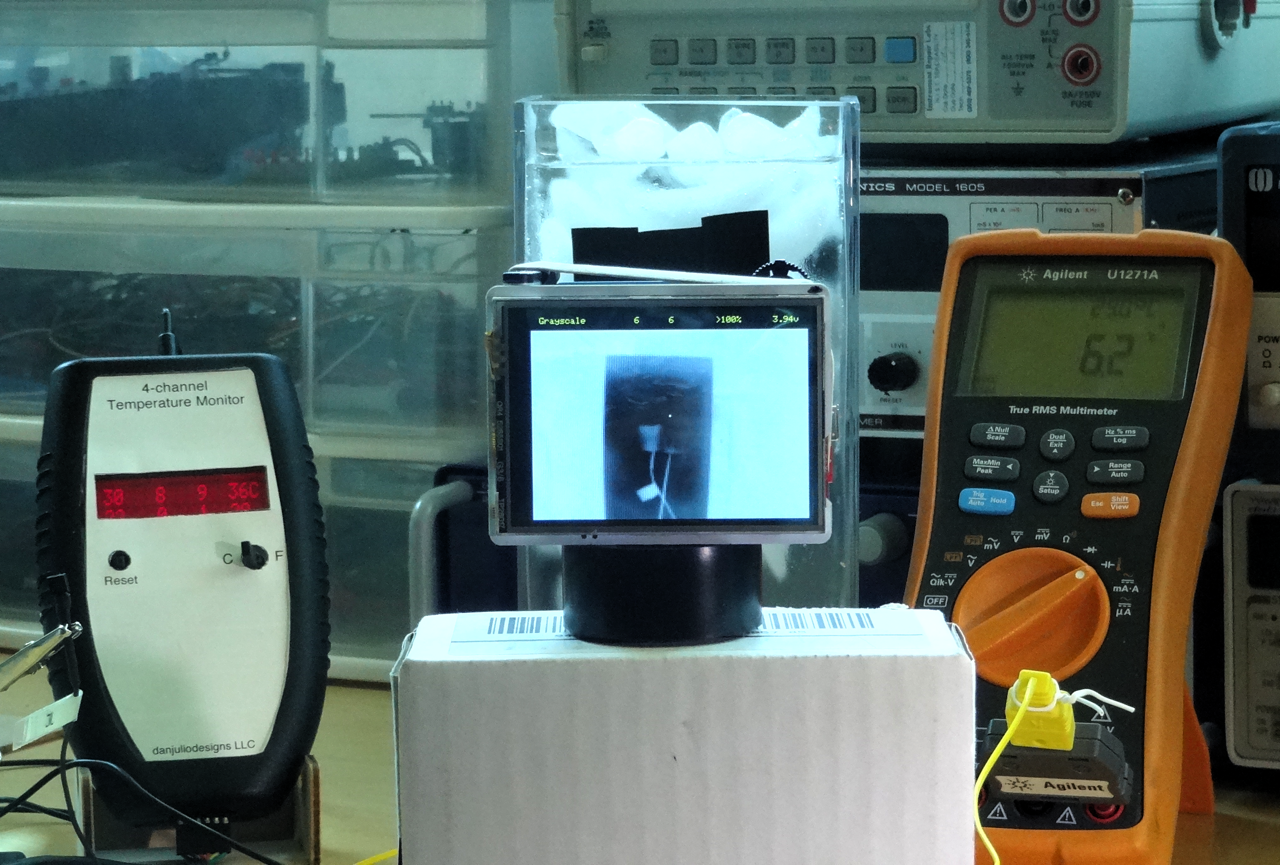Determining the accuracy of temperature readings made with the camera is a bit tricky. FLIR's documentation indicates it varies with ambient temperature, scene temperature and object emissivity. They seem to do their characterization at 25°C against a 35°C blackbody. They claim a typical accuracy of +/- 5°C or 5% and a range of accuracies up to +/- 8°C, depending on conditions. Ambient temperatures seem to make a large impact (the lepton measures its internal temperature but I'm not sure if external temperature affects its accuracy). My reading about this class of device also indicates that the emissivity of the object being measured also impacts accuracy - although it's not clear, other than when enclosing the lepton behind a lens of some kind, adjustments need to be made to its default parameters.
Wanting to see how accurate my lepton is, I hacked lep_test6 into lep_test9 (in the github repository) adding the ability to change the emissivity in the RAD Flux Linear parameters setting as well as compare the output of the spot meter function (that can average a specified set of pixels in a specified location in the image) with output pixel data. The spot meter can be used to get temperature when AGC is enabled and the pixel data does not contain actual temperature values.

I then attempted to compare the temperature output from the Lepton with other temperature measuring devices for a variety of materials and object temperatures (being a hot summer day, I didn't get much opportunity to play with the ambient temperature). I would call this very amateur science...
Short summary: I found the device fairly accurate without having to change the default emissivity setting (with one exception) and the spot meter works as advertised. Emissivity investigation will have to wait for another day.
Longer Description + some data
The test setup included a 4-channel Dallas DS18B20 temperature probe I made years ago, an Agilent multimeter with a type K thermocouple and a home-made IR Thermometer based on the Melexis MLX90614 sensor. I attempted to use either one DS18B20 or the Agilent probe to capture the ambient temperature and then as many sensors as possible to also read the object temperature. Basic claimed accuracy (over the temperature ranges I used) of the DS18B20 sensors is +/- 0.5°C, for the Agilent sensor, 1% + 1°C and for the Melexis sensor, 0.5°C.

I held the Melexis sensor very close to the object since it has a very wide field of view and averages all the thermal energy in its scene. Here it is measuring the temperature of a "blackbody" (electrical tape) on the side of a vase of ice water.

Measuring temperature is hard... There is the basic accuracy of the sensor itself and then how it interacts with the environment. I saw a quite bit of variability for all sensors, especially the IR sensors. The DS18B20 sensors tracked each other very well. However I think that the lead temperature makes a big difference so when their plastic cases were touching an object, the temperatures recorded may have been wrong because the leads were at a slightly different temperature. The thermocouple varied based how it touched the object (although it has very fast settling time).

As can be seen from the data, the Lepton generally agreed with the other sensors. I expected worse performance, partly because of the device specs and partly because I expected the surface emissivity to play a bigger role.
Not included in the above table (a late add) was a measurement of a soldering iron set to 350°C. The Lepton read 181°C and it wasn't until the emissivity setting was lowered to 35% that the temp was close (353°C). I'm not sure why and would love to hear any thoughts...
 Dan Julio
Dan Julio
Discussions
Become a Hackaday.io Member
Create an account to leave a comment. Already have an account? Log In.
"Not included in the above table (a late add) was a measurement of a soldering iron set to 350°C. The Lepton read 181°C and it wasn't until the emissivity setting was lowered to 35% that the temp was close (353°C). I'm not sure why and would love to hear any thoughts..."
The Lepton has two gain modes, high and low gain. The high gain mode, according to the datasheet, is only able to reach temperatures from -10°C upto 180°C. Probably, by lowering the emissivity, the Lepton automatically switched over to low gain mode (-10°C-400°C if I'm not mistaken). Just sharing my thoughts!
Are you sure? yes | no